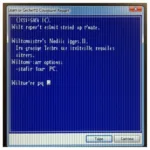Owning a car means inevitably facing maintenance issues, and a faulty manual car window mechanism can be one of those unexpected headaches. While it might seem daunting, understanding the basics of this system and learning some DIY repair techniques can save you a trip to the mechanic and keep your car windows rolling smoothly.
Demystifying the Manual Window Mechanism
Before diving into repairs, it’s crucial to understand how the manual car window mechanism operates. This system, unlike its electric counterpart, relies on a series of gears and levers to move the window glass up and down.
Here’s a breakdown of the key components:
- Crank Handle: This is the part you interact with directly. Turning it rotates a gear train within the door panel.
- Gears: These transfer the rotational force from the crank handle to the window regulator.
- Window Regulator: This component, often consisting of a scissor-like mechanism or a cable and pulley system, moves the window glass along its tracks.
- Window Tracks: These guide the window glass and ensure smooth movement within the door frame.
Common Manual Car Window Mechanism Issues
Knowing the usual suspects behind window mechanism failures can help you diagnose the problem accurately:
- Worn-out Gears: Years of use can wear down the teeth of the gears, leading to slipping or difficulty cranking the window.
- Damaged Regulator: A bent or broken regulator arm or a frayed cable can prevent the window from moving smoothly or at all.
- Misaligned Tracks: If the window tracks become bent or clogged with debris, it can obstruct the window’s movement.
- Loose Handle: A loose crank handle can make it difficult to engage the gears properly, hindering window operation.
DIY Manual Car Window Mechanism Repair
While some issues might require professional help, many manual car window problems can be tackled with some basic tools and a little patience. Let’s look at a step-by-step guide for a typical repair scenario:
1. Gather Your Tools:
You’ll need a screwdriver set, pliers, socket wrench, a shop rag, and a can of lubricant. Having a flashlight handy can be helpful for better visibility inside the door panel.
2. Prepare the Work Area:
Park your car on a level surface, engage the parking brake, and disconnect the negative battery cable as a safety precaution.
3. Access the Window Mechanism:
Remove the door panel by carefully prying off any trim pieces and unscrewing the retaining screws. Once the panel is loose, disconnect any electrical connectors for power windows or locks.
4. Diagnose the Problem:
With the window mechanism exposed, inspect the gears, regulator, tracks, and crank handle for any visible signs of damage or wear.
5. Address the Issue:
- For worn-out gears, you’ll likely need to replace the entire regulator assembly.
- If the regulator is damaged, you can attempt to repair it by straightening bent parts or replacing the cable. However, replacement is often the more reliable solution.
- Clean the window tracks thoroughly and remove any debris. You can also use a lubricant to ensure smooth movement.
- Tighten any loose screws or bolts securing the crank handle or other components.
6. Reassemble and Test:
Once the repair is complete, carefully reassemble the door panel and reconnect any electrical connectors. Reattach the negative battery cable and test the window operation.
When to Seek Professional Help
While DIY repairs can be satisfying and cost-effective, there are instances where professional intervention is necessary:
- Extensive Damage: If multiple components are severely damaged or the problem lies within the door frame itself, it’s best left to the experts.
- Lack of Expertise: If you’re uncomfortable working with car parts or lack the necessary tools and knowledge, seeking professional help can save you time and potential further damage.
- Safety Concerns: Always prioritize safety. If you encounter any electrical components or are unsure about any step of the repair process, it’s best to consult a professional.
Maintaining Your Manual Car Windows
Like any mechanical system, regular maintenance can significantly extend the lifespan of your manual car windows. Here are some preventative measures:
- Lubrication: Regularly lubricate the window tracks and moving parts of the regulator with a silicone-based lubricant to prevent wear and tear.
- Cleaning: Keep the window tracks free from dirt, debris, and obstructions to ensure smooth operation.
- Gentle Operation: Avoid forcing the crank handle if you encounter resistance. Stop and investigate the cause to prevent further damage.
[1997 lincoln town car power window repair](https://carrepairon.com/1997-lincoln-town car-power-window-repair/)
Conclusion
Understanding the mechanics of your car and learning some basic repair techniques can empower you as a car owner. While a faulty manual car window mechanism might seem like a major inconvenience, it can often be resolved with some DIY effort. By following the steps outlined in this guide and adhering to regular maintenance practices, you can keep your car windows functioning optimally for years to come.
FAQs
1. How often should I lubricate my manual car windows?
It’s recommended to lubricate your window tracks and regulator mechanisms at least twice a year, or more frequently if you live in a dusty or extreme climate.
2. Can I replace just the gears in my manual window regulator?
While it might be possible in some cases, replacing the entire regulator assembly is generally recommended to ensure proper alignment and long-term reliability.
3. Why is my manual car window making a grinding noise?
A grinding noise usually indicates worn-out gears, a damaged regulator, or an obstruction in the window tracks. It’s essential to diagnose the cause and address it promptly to prevent further damage.
4. How much does it cost to replace a manual car window regulator?
The cost can vary depending on the make and model of your car. It’s best to contact a trusted mechanic or dealership for a quote.
5. Can I use WD-40 to lubricate my car windows?
While WD-40 can temporarily free up stuck parts, it’s not ideal for long-term lubrication. It’s best to use a silicone-based lubricant specifically designed for automotive applications.
Need Help? Contact Us!
If you need assistance with your car window mechanism repair, don’t hesitate to contact our team of experts through WhatsApp: +1(641)206-8880, or email us at: [email protected]. We provide 24/7 customer support and are always ready to help!


